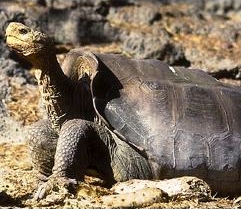Hood Island giant tortoise facts for kids
Quick facts for kids Hood Island giant tortoise |
|
|---|---|
 |
|
| Conservation status | |
| Scientific classification |
|
| Kingdom: | Animalia |
| Phylum: | Chordata |
| Class: | Reptilia |
| Order: | Testudines |
| Suborder: | Cryptodira |
| Family: | Testudinidae |
| Genus: | Chelonoidis |
| Species: | |
| Subspecies: |
C. n. hoodensis
|
| Trinomial name | |
| Chelonoidis niger hoodensis (Van Denburgh, 1907)
|
|
| Synonyms | |
|
|
The Hood Island giant tortoise (Chelonoidis niger hoodensis) is a special type of Galápagos tortoise. It lives only on Española Island in the Galápagos. This makes it endemic to that island, meaning you won't find it naturally anywhere else in the world!
Contents
Bringing Back the Hood Island Tortoise
The Hood Island giant tortoise faced a tough time in the 1800s. Whalers hunted them a lot, and their numbers dropped very low by the 1850s. It looked like they might disappear forever.
A New Beginning for the Tortoises
In the early 1970s, scientists found only 13 adult tortoises left on Española Island. These 13 (two males and eleven females) were taken to the Charles Darwin Research Station. Here, they started a special breeding program to help the tortoises have babies in a safe place.
Diego the Hero Tortoise
Luckily, a third male tortoise named Diego was found at the San Diego Zoo. He joined the breeding program, which was a huge help! Before this, the tortoises on the island were so spread out that they couldn't find each other to mate naturally.
Success and Return to the Wild
Thanks to the breeding program, many baby tortoises were born. These young tortoises were then released back onto Española Island. They are now breeding on their own, and their population has grown a lot! By August 2020, there were over 2,300 Hood Island giant tortoises living freely on the island.
What Does a Hood Island Tortoise Look Like?
The Hood Island giant tortoise is one of the smaller types of Galápagos tortoise. It has a black shell, called a carapace. This shell is shaped like a saddle, which means it curves upwards at the front.
Shell Features
The front edge of its shell is slightly turned up. The back edges are turned down and have a few small bumps, like tiny teeth. The shell is narrower at the front and gets wider towards the back.
Why Is It Called That?
The name hoodensis comes from "Hood," which is another name for Española Island. The Latin ending "-ensis" means "who lives in." So, the name simply means "the tortoise who lives on Hood Island."
See also
 In Spanish: Tortuga gigante de la Española para niños
In Spanish: Tortuga gigante de la Española para niños


